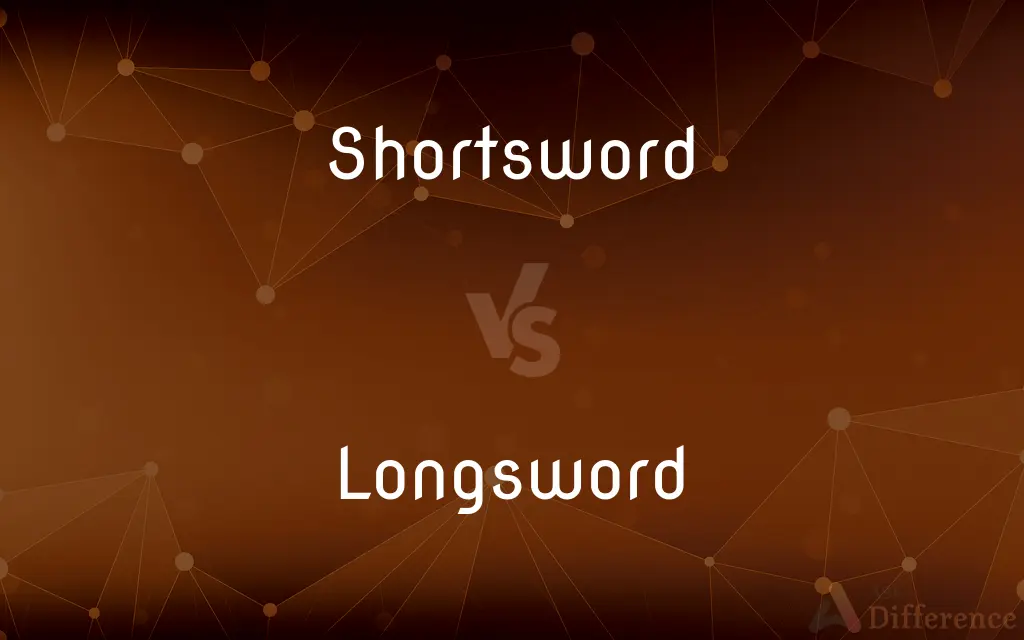Shortsword vs. Longsword — What's the Difference?
By Tayyaba Rehman & Maham Liaqat — Updated on March 31, 2024
A shortsword is a light, one-handed weapon, while a longsword is longer, often requiring two hands.

Difference Between Shortsword and Longsword
Table of Contents
ADVERTISEMENT
Key Differences
Shortswords, characterized by their light weight and shorter blade, are designed for one-handed use, making them ideal for close combat and for use alongside a shield. They offer agility and ease of handling in tight spaces, allowing for quick, precise strikes. Longswords, with their longer blades and sometimes larger hilts, are typically used with both hands, providing greater reach and the ability to deliver powerful blows. This design makes them versatile on the battlefield, suitable for both cutting and thrusting actions against opponents.
The historical context of shortswords and longswords differs significantly. Shortswords were prominent in early civilizations, such as ancient Rome, where the gladius was a key military weapon. Their popularity persisted due to their practicality in close combat situations. Longswords gained prominence in the Middle Ages in Europe, symbolizing the knightly virtue and martial skill, and were a staple in the armament of knights and soldiers, reflecting advancements in metallurgy and combat techniques.
In terms of technique, shortsword fighters often rely on speed and precision, exploiting openings in an opponent's defense with rapid thrusts and cuts. The weapon's lighter weight allows for a faster response time and less fatigue during prolonged use. Longsword fighters, however, utilize a range of techniques that include powerful swings, thrusts, and even grappling, making use of the weapon's length and weight to overpower opponents. The longsword's versatility in combat allows for a wide array of fighting styles, from the German school of fencing to the Italian tradition.
The versatility of the longsword also extends to its use in different combat scenarios. It can be effective in both one-on-one duels and on the battlefield against multiple opponents, thanks to its reach and power. The shortsword, while potentially less versatile in open combat, excels in confined spaces and as a secondary weapon, providing soldiers and warriors with a reliable means of defense and attack when other options are not feasible.
Despite their differences, both shortswords and longswords share a place in the history of warfare and martial arts. Each weapon has its unique advantages and disadvantages, depending on the context of the fight and the strategy of the combatant. The choice between a shortsword and a longsword would depend on various factors, including the wearer's fighting style, the expected combat scenario, and the technological advancements of the time.
ADVERTISEMENT
Comparison Chart
Blade Length
Shorter, typically under 24 inches
Longer, often over 35 inches
Usage
One-handed
Mainly two-handed
Combat Style
Quick, precise strikes; close combat
Powerful swings, versatile techniques
Historical Context
Ancient civilizations, close combat
Middle Ages, symbol of knightly virtue
Technique Focus
Speed and agility
Reach, power, and versatility
Versatility in Combat
Suited for close quarters and as a secondary weapon
Effective in both duels and against multiple opponents
Compare with Definitions
Shortsword
Ideal for close combat and tight spaces.
In narrow alleyways, the shortsword was the preferred weapon.
Longsword
Versatile in combat techniques.
Longsword fighters utilized a range of swings, thrusts, and even grappling.
Shortsword
Common in ancient to medieval periods.
Shortswords were prevalent in both Roman and medieval European warfare.
Longsword
Symbolized knightly virtue.
The longsword was often associated with the ideals of chivalry and knightly honor.
Shortsword
Often paired with a shield for defense.
Soldiers would wield a shortsword in one hand and a shield in the other.
Longsword
Effective against multiple opponents.
Its reach and power made the longsword formidable on the battlefield.
Shortsword
Offers quick, precise strikes.
He used the shortsword to exploit gaps in his opponent's armor.
Longsword
Longer blade requires two hands.
The longsword's design allowed for powerful, two-handed strikes.
Shortsword
Light and designed for one-handed use.
The Roman gladius, a type of shortsword, was essential for legionaries.
Longsword
Suited for duels and open-field battles.
Knights would favor longswords in both tournament duels and warfare.
Shortsword
A sword of a class generally shorter than one meter, but longer than a dagger.
Longsword
A longsword (also spelled as long sword or long-sword) is a type of European sword characterized as having a cruciform hilt with a grip for two-handed use (around 16 to 28 cm or 6 to 11 in), a straight double-edged blade of around 85 to 110 cm (33 to 43 in), and weighing approximately 1 to 1.5 kg (2 lb 3 oz to 3 lb 5 oz).The "longsword" type exists in a morphological continuum with the medieval knightly sword and the Renaissance-era Zweihänder. It was prevalent during the late medieval and Renaissance periods (approximately 1350 to 1550), with early and late use reaching into the 12th and 17th centuries.
Longsword
A sword with a long blade, especially one designed to be used with two hands.
Longsword
Usually with capital initial. (An epithet of) William, third earl of Salisbury (1167–1226), the illegitimate son of King Henry II of England and Ida de Tosny, and his son, also named William (1209–50).
Longsword
Any type of sword that is comparatively long; depending on context, applied to swords of the Bronze Age, Migration period, Viking Age and Renaissance era.
Longsword
A European sword with a long, straight double-edged blade, a cruciform hilt, and a grip for two-handed use; prevalent from the 14th to 16th centuries.
Common Curiosities
Were shortswords only used by ancient civilizations?
While popular in ancient times, shortswords continued to be used through the medieval period, often as secondary weapons.
Is there a significant difference in the weight of these swords?
Yes, shortswords are lighter and designed for quick use, while longswords are heavier, requiring both strength and skill for effective use.
Why would a warrior choose a longsword over a shortsword?
A warrior might choose a longsword for its greater reach, power, and versatility in both dueling and battlefield scenarios.
Were there any famous battles where shortswords proved decisive?
In ancient battles, particularly those involving Roman legions, the gladius (a type of shortsword) played a crucial role in close-quarters combat.
Did knights exclusively use longswords?
While the longsword was symbolic of knights, they also used a variety of weapons depending on the situation, including lances, maces, and axes.
Can a longsword be used with one hand?
While primarily designed for two-handed use, some longsword techniques and variants can be wielded with one hand, especially when paired with a shield or in certain fighting styles.
How did the combat techniques differ between shortsword and longsword fighters?
Shortsword fighters focused on speed and precision, while longsword fighters utilized a broader range of techniques, including power strikes, thrusts, and grappling.
How does the fighting style of shortswords compare to modern fencing?
Modern fencing can trace some techniques back to historical swordsmanship, including agility and precision, though it is more stylized and governed by specific rules.
What historical period is most associated with the longsword?
The longsword is most associated with the Middle Ages, reflecting its role in the armament of knights and its symbolism of martial skill and knightly virtue.
What is the primary advantage of a shortsword?
The primary advantage is its agility and ease of handling in close combat, allowing for quick, precise strikes.
What materials were used in the making of shortswords and longswords?
Both were primarily made of steel, with variations in composition and tempering techniques over time to enhance strength and durability.
Could a shortsword and a longsword be used together in combat?
Typically, a fighter would choose one based on the combat scenario; however, a shortsword could serve as a secondary or backup weapon alongside a primary weapon like a longsword.
What role did longswords play in medieval society beyond warfare?
Longswords were symbols of status and honor, often used in ceremonies and as part of the knightly identity.
Share Your Discovery

Previous Comparison
Scandalised vs. Scandalized
Next Comparison
Construction vs. ConstrueAuthor Spotlight
Written by
Tayyaba RehmanTayyaba Rehman is a distinguished writer, currently serving as a primary contributor to askdifference.com. As a researcher in semantics and etymology, Tayyaba's passion for the complexity of languages and their distinctions has found a perfect home on the platform. Tayyaba delves into the intricacies of language, distinguishing between commonly confused words and phrases, thereby providing clarity for readers worldwide.
Co-written by
Maham Liaqat














































